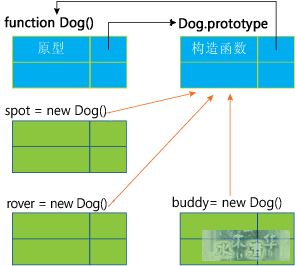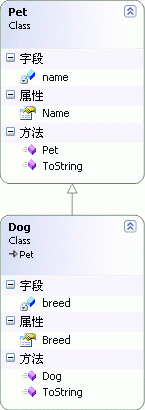var userObject = new Object(); userObject.lastLoginTime = new Date(); alert(userObject.lastLoginTime);
的功能与下面的代码段完全相同:
var userObject = {}; // equivalent to new Object()
userObject[“lastLoginTime”] = new Date();
alert(userObject[“lastLoginTime”]);
我们还可以直接在 userObject 的定义中定义 lastLoginTime 属性,如下所示:
var userObject = { “lastLoginTime”: new Date() };
alert(userObject.lastLoginTime);
function func(x) {
alert(x);
}
func(“blah”);
这就是通常在 JavaScript 中定义函数的方法。但是,还可以按以下方法定义该函数,您在此创建匿名函数对象,并将它赋给变量 func
var func = function(x) {
alert(x);
};
func(“blah2”);
甚至也可以像下面这样,使用 Function 构造函数:
var func = new Function(“x”, “alert(x);”); func(“blah3”);
function sayHi(x) {
alert(“Hi, “ + x + “!”);
}
sayHi.text = “Hello World!”;
sayHi[“text2”] = “Hello World... again.”;
alert(sayHi[“text”]); // displays “Hello World!”
alert(sayHi.text2); // displays “Hello World... again.”
 Figure 1 JavaScript 中的函数是最棒的
Figure 1 JavaScript 中的函数是最棒的// assign an anonymous function to a variable
var greet = function(x) {
alert(“Hello, “ + x);
};
greet(“MSDN readers”);
// passing a function as an argument to another
function square(x) {
return x * x;
}
function operateOn(num, func) {
return func(num);
}
// displays 256
alert(operateOn(16, square));
// functions as return values
function makeIncrementer() {
return function(x) { return x + 1; };
}
var inc = makeIncrementer();
// displays 8
alert(inc(7));
// functions stored as array elements
var arr = [];
arr[0] = function(x) { return x * x; };
arr[1] = arr[0](2);
arr[2] = arr[0](arr[1]);
arr[3] = arr[0](arr[2]);
// displays 256
alert(arr[3]);
// functions as object properties
var obj = { “toString” : function() { return “This is an object.”; } };
// calls obj.toString()
alert(obj);
var myDog = {
“name” : “Spot”,
“bark” : function() { alert(“Woof!”); },
“displayFullName” : function() {
alert(this.name + “ The Alpha Dog”);
},
“chaseMrPostman” : function() {
// implementation beyond the scope of this article
}
};
myDog.displayFullName();
myDog.bark(); // Woof!
 Figure 2 “this”随对象更改而更改
Figure 2 “this”随对象更改而更改function displayQuote() {
// the value of “this” will change; depends on
// which object it is called through
alert(this.memorableQuote);
}
var williamShakespeare = {
“memorableQuote”: “It is a wise father that knows his own child.”,
“sayIt” : displayQuote
};
var markTwain = {
“memorableQuote”: “Golf is a good walk spoiled.”,
“sayIt” : displayQuote
};
var oscarWilde = {
“memorableQuote”: “True friends stab you in the front.”
// we can call the function displayQuote
// as a method of oscarWilde without assigning it
// as oscarWilde’s method.
//”sayIt” : displayQuote
};
williamShakespeare.sayIt(); // true, true
markTwain.sayIt(); // he didn’t know where to play golf
// watch this, each function has a method call()
// that allows the function to be called as a
// method of the object passed to call() as an
// argument.
// this line below is equivalent to assigning
// displayQuote to sayIt, and calling oscarWilde.sayIt().
displayQuote.call(oscarWilde); // ouch!
alert(“NaN is NaN: “ + isNaN(NaN));
function x() {
this.isNaN = function() {
return “not anymore!”;
};
}
// alert!!! trampling the Global object!!!
x();
alert(“NaN is NaN: “ + isNaN(NaN));
Dog spot = new Dog();
将返回一个对象,该对象是 Dog 类的实例。但在 JavaScript 中,本来就没有类。与访问类最近似的方法是定义构造函数,如下所示:
function DogConstructor(name) {
this.name = name;
this.respondTo = function(name) {
if(this.name == name) {
alert(“Woof”);
}
};
}
var spot = new DogConstructor(“Spot”);
spot.respondTo(“Rover”); // nope
spot.respondTo(“Spot”); // yeah!
那么,结果会怎样呢?暂时忽略 DogConstructor 函数定义,看一看这一行:
var spot = new DogConstructor(“Spot”);
// create an empty object
var spot = {};
// call the function as a method of the empty object
DogConstructor.call(spot, “Spot”);
正如在 DogConstructor 主体中看到的那样,调用此函数将初始化对象,在调用期间关键字“this”将引用此对象。这样,就可以为对象创建模板!只要需要创建类似的对象,就可以与构造函数一起调用“new”,返回的结果将是一个完全初始化的对象。这与类非常相似,不是吗?实际上,在 JavaScript 中构造函数的名称通常就是所模拟的类的名称,因此在上面的示例中,可以直接命名构造函数 Dog:
// Think of this as class Dog
function Dog(name) {
// instance variable
this.name = name;
// instance method? Hmmm...
this.respondTo = function(name) {
if(this.name == name) {
alert(“Woof”);
}
};
}
var spot = new Dog(“Spot”);
function respondTo() {
// respondTo definition
}
function Dog(name) {
this.name = name;
// attached this function as a method of the object
this.respondTo = respondTo;
}
var buddy = new Dog(“Buddy“);
buddy 所引用的对象将从它的原型继承属性和方法,尽管仅从这一行可能无法明确判断原型来自哪里。对象 buddy 的原型来自构造函数(在这里是函数 Dog)的属性。

 Figure 4 对象具有其原型的属性
Figure 4 对象具有其原型的属性var spot = new Dog(“Spot”); // Dog.prototype is the prototype of spot alert(Dog.prototype.isPrototypeOf(spot)); // spot inherits the constructor property // from Dog.prototype alert(spot.constructor == Dog.prototype.constructor); alert(spot.constructor == Dog); // But constructor property doesn’t belong // to spot. The line below displays “false” alert(spot.hasOwnProperty(“constructor”)); // The constructor property belongs to Dog.prototype // The line below displays “true” alert(Dog.prototype.hasOwnProperty(“constructor”));

Dog.prototype = new Object();

- 继承原型对象的对象上可以立即呈现对原型所做的更改,即使是在创建这些对象之后。
- 如果在对象中定义了属性/方法 X,则该对象的原型中将隐藏同名的属性/方法。例如,通过在 Dog.prototype 中定义 toString 方法,可以改写 Object.prototype 的 toString 方法。
- 更改只沿一个方向传递,即从原型到它的派生对象,但不能沿相反方向传递。
 Figure 7 继承原型
Figure 7 继承原型function GreatDane() { }
var rover = new GreatDane();
var spot = new GreatDane();
GreatDane.prototype.getBreed = function() {
return “Great Dane”;
};
// Works, even though at this point
// rover and spot are already created.
alert(rover.getBreed());
// this hides getBreed() in GreatDane.prototype
spot.getBreed = function() {
return “Little Great Dane”;
};
alert(spot.getBreed());
// but of course, the change to getBreed
// doesn’t propagate back to GreatDane.prototype
// and other objects inheriting from it,
// it only happens in the spot object
alert(rover.getBreed());
function DateTime() { }
// set static method now()
DateTime.now = function() {
return new Date();
};
alert(DateTime.now());
 Figure 8 根据谓词筛选元素
Figure 8 根据谓词筛选元素function filter(pred, arr) {
var len = arr.length;
var filtered = []; // shorter version of new Array();
// iterate through every element in the array...
for(var i = 0; i < len; i++) {
var val = arr[i];
// if the element satisfies the predicate let it through
if(pred(val)) {
filtered.push(val);
}
}
return filtered;
}
var someRandomNumbers = [12, 32, 1, 3, 2, 2, 234, 236, 632,7, 8];
var numbersGreaterThan100 = filter(
function(x) { return (x > 100) ? true : false; },
someRandomNumbers);
// displays 234, 236, 632
alert(numbersGreaterThan100);
var greaterThan300 = filter(
function(x) { return (x > 300) ? true : false; },
someRandomNumbers);
function makeGreaterThanPredicate(lowerBound) {
return function(numberToCheck) {
return (numberToCheck > lowerBound) ? true : false;
};
}
这样,您就可以编写以下代码:
var greaterThan10 = makeGreaterThanPredicate(10); var greaterThan100 = makeGreaterThanPredicate(100); alert(filter(greaterThan10, someRandomNumbers)); alert(filter(greaterThan100, someRandomNumbers));
function Person(name, age) {
this.getName = function() { return name; };
this.setName = function(newName) { name = newName; };
this.getAge = function() { return age; };
this.setAge = function(newAge) { age = newAge; };
}
var ray = new Person(“Ray”, 31);
alert(ray.getName());
alert(ray.getAge());
ray.setName(“Younger Ray”);
// Instant rejuvenation!
ray.setAge(22);
alert(ray.getName() + “ is now “ + ray.getAge() +
“ years old.”);
function Person(name, age) {
var occupation;
this.getOccupation = function() { return occupation; };
this.setOccupation = function(newOcc) { occupation =
newOcc; };
// accessors for name and age
}
注意,这些私有成员与我们期望从 C# 中产生的私有成员略有不同。在 C# 中,类的公用方法可以访问它的私有成员。但在 JavaScript 中,只能通过在其闭包内拥有这些私有成员的方法来访问私有成员(由于这些方法不同于普通的公用方法,它们通常被称为特权方法)。因此,在 Person 的公用方法中,仍然必须通过私有成员的特权访问器方法才能访问私有成员:
Person.prototype.somePublicMethod = function() {
// doesn’t work!
// alert(this.name);
// this one below works
alert(this.getName());
};

// class Pet
function Pet(name) {
this.getName = function() { return name; };
this.setName = function(newName) { name = newName; };
}
Pet.prototype.toString = function() {
return “This pet’s name is: “ + this.getName();
};
// end of class Pet
var parrotty = new Pet(“Parrotty the Parrot”);
alert(parrotty);
 Figure 10 从 Pet 类派生
Figure 10 从 Pet 类派生// class Dog : Pet
// public Dog(string name, string breed)
function Dog(name, breed) {
// think Dog : base(name)
Pet.call(this, name);
this.getBreed = function() { return breed; };
// Breed doesn’t change, obviously! It’s read only.
// this.setBreed = function(newBreed) { name = newName; };
}
// this makes Dog.prototype inherits
// from Pet.prototype
Dog.prototype = new Pet();
// remember that Pet.prototype.constructor
// points to Pet. We want our Dog instances’
// constructor to point to Dog.
Dog.prototype.constructor = Dog;
// Now we override Pet.prototype.toString
Dog.prototype.toString = function() {
return “This dog’s name is: “ + this.getName() +
“, and its breed is: “ + this.getBreed();
};
// end of class Dog
var dog = new Dog(“Buddy”, “Great Dane”);
// test the new toString()
alert(dog);
// Testing instanceof (similar to the is operator)
// (dog is Dog)? yes
alert(dog instanceof Dog);
// (dog is Pet)? yes
alert(dog instanceof Pet);
// (dog is Object)? yes
alert(dog instanceof Object);
var MSDNMagNS = {};
MSDNMagNS.Pet = function(name) { // code here };
MSDNMagNS.Pet.prototype.toString = function() { // code };
var pet = new MSDNMagNS.Pet(“Yammer”);
var MSDNMagNS = {};
// nested namespace “Examples”
MSDNMagNS.Examples = {};
MSDNMagNS.Examples.Pet = function(name) { // code };
MSDNMagNS.Examples.Pet.prototype.toString = function() { // code };
var pet = new MSDNMagNS.Examples.Pet(“Yammer”);
可以想象,键入这些冗长的嵌套命名空间会让人很累。 幸运的是,库用户可以很容易地为命名空间指定更短的别名:
// MSDNMagNS.Examples and Pet definition... // think “using Eg = MSDNMagNS.Examples;” var Eg = MSDNMagNS.Examples; var pet = new Eg.Pet(“Yammer”); alert(pet);
function object(o) {
function F() {}
F.prototype = o;
return new F();
}
然后,由于 JavaScript 中的对象是可延展的,因此可以方便地在创建对象之后,根据需要用新字段和新方法增大对象。


评论